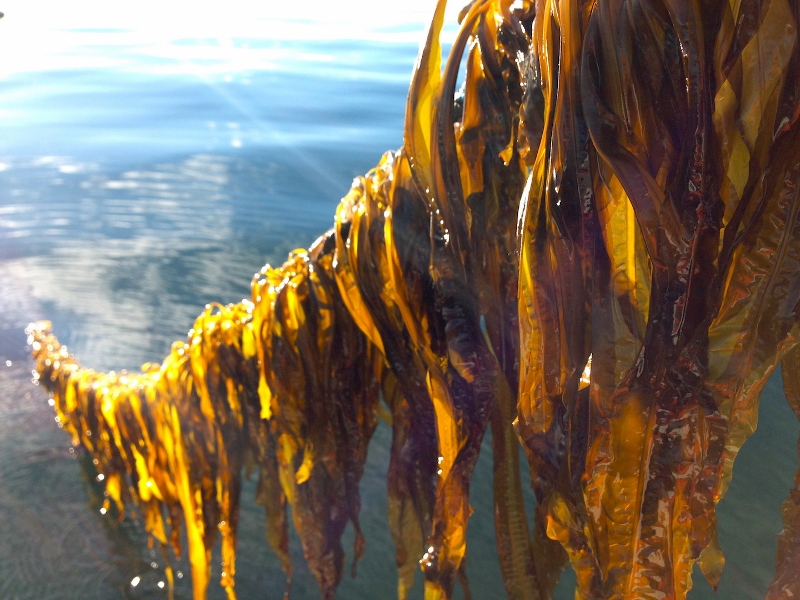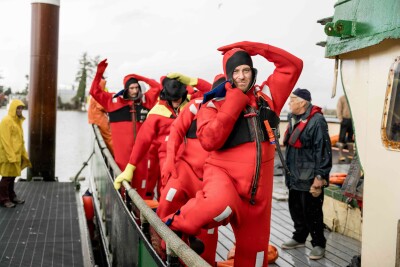Underwater and out of sight are the makings of a major Alaska industry with two anchor crops that clean the planet while pumping out lots of cash: shellfish and seaweed.
Alaskans have now applied for over 2,000 acres of new or expanding undersea farms, double the footprint from two years ago, ranging in size from .02 acres at Halibut Cove to nearly 300 acres at Craig.
Nearly 60 percent of the newest applicants plan to grow kelp with the remainder growing a mix of kelp and/or Pacific oysters, said Cynthia Pring-Ham, aquatic farming coordinator at the Alaska Dept. of Fish and Game which issues the permits. ADF&G partners with the Dept. of Natural Resources which leases the tidal and submerged lands for farms.
Currently in Alaska 36 operators are producing primarily Pacific oysters in Southeast, Prince William Sound and Kachemak Bay. Their combined crops of about two million bivalves have sales topping $1.5 million from a mostly local customer base.
It’s the faster growing seaweed that has spawned wider interest, especially from regions that aren’t as hospitable to growing shellfish.
Alaska’s first kelp farm permits were issued in 2016 at Kodiak; 15,000 pounds of brown and sugar kelp was harvested in 2017 and sold to California food maker Blue Evolution for $10,000. Last year the Kodiak output jumped to 90,000 pounds worth over $33,000.
Now, besides kelp, 21 Alaska growers also have added dulce, nori and sea lettuce to their macroalgae or shellfish menus. It will go into a global commercial seaweed market that is projected to top $22 billion by 2024, with human consumption as the largest segment.
The interest is quickly spreading to other Alaska regions. This year two kelp applications were submitted from Sand Point and queries have come from the Pribilof Islands, said Julie Decker, chair of a state mariculture task force created in 2016 by former Governor Bill Walker to lay the foundation for “a $100 million industry in 20 years.”
“People are calling from St. Paul and St. George in the Bering Sea. They are interested and want to know what they need to do to get started,” she said.
“I can’t see a single downside to it,” said Sam Rabung, director of the Alaska Dept. of Fish and Game commercial fisheries division and a task force member.
Rabung, who began researching kelp in Japan in the 1980s and has worked in salmon enhancement and mariculture in Alaska for over 35 years, called diversification into seaweed farming “the biggest change to the industry I’ve seen in the last five years.”
It is getting legs for several reasons, he said.
“It’s a really good fit with our existing fishery infrastructure. We have a blue workforce, an ocean workforce of fishing communities, vessels, fishermen, processors that in many cases get used in a kind of boom and bust manner. This gives an additional shoulder to a season,” he said.
“The giant kelp that we’re focusing on in Alaska right now, the brown algae, can be used for everything from food to nutritional supplements to animal feed ingredients, biofuels, soil amendments and everything in between. We’re just at the tip of the iceberg in terms of the uses of algae,” he added.
Plus, growing seaweed benefits the planet. As the “trees” of coastal ecosystems, seaweeds pull massive amounts of carbon from the atmosphere, absorbing five times more than land-based plants.
But planting the earth friendly kelp fronds in the fall and plucking them in the spring is the easy part.
“What do you do when you harvest them? You need to have something in place to take the product and make use of it before you ever plant your seeded lines,” Rabung said.
As the fledgling algae industry develops, the task force is advocating that some growers form clusters to “really get things going.”
“Getting a larger number of farms concentrated around a hub to get the synergy to create that critical mass and reduce the cost of logistics, transports, and support services that the farms need,” Rabung explained. “We need it to become a company, an industry. That’s where the state will see its biggest benefit.”
At least two Alaska processors, Ocean Beauty and Silver Bay Seafoods, are involved in the new industry and buyers want product.
“They need to know there is enough steady volume to make sure it’s worthwhile,” Rabung said.
An early obstacle for aspiring Alaska growers, Rabung said, is financing although the state’s revolving loan fund has made its first loan for a kelp farm.
He said another is “acceptability.”
“The way our statutes are written aquatic farming is the lowest priority use of coastal waters,” he said. “When we review a farm permit, we’re looking at its compatibility with existing uses as one of the criteria, such as fisheries. We can’t put farms in places that are traditional seine hook offs or troll drags or dive fisheries or subsistence harvest areas.”
Applicants also must be aware of navigational hazards and marine mammal haul outs when they are siting their farms. An online, interactive GIS map showing site areas and other data for Alaska’s entire coastline is being compiled and will help provide more information. It also can be shared with state agencies to help speed up the permitting process which has a two year backlog.
“We’re kind of victims of own success because for years we’ve been building a foundation and network of people all working in the same direction. Now the industry is stepping up and submitting applications for new farms and it coincides with staff and budget reductions at DNR,” Decker said.
She added that the Dunleavy administration is “enthusiastic” about the mariculture industry’s potential.
“We’re getting really good interest and support,” Decker said, “All the pieces are in place to move forward.”
Farmer training sessions will be held next year in Ketchikan, Sitka and Kodiak and perhaps other communities, Decker said.
Julie Decker will host a Seaweed Farming 101/Alaska Mariculture session at Pacific Marine Expo in Seattle on Friday, Nov. 22, 2019. Visit Pacific Marine Expo for details.







